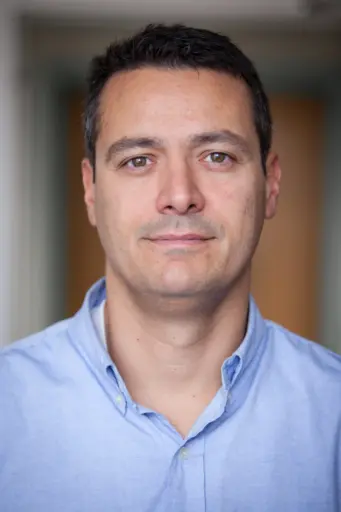Fossil fuels seep their way into almost every aspect of American life.
Transportation, heating and the plastics and chemicals we use every day all rely on petroleum products, but our insatiable appetite for fossil fuels will have catastrophic consequences for the health of the planet if left unchecked.
 Christos Maravelias. Photo: Matt Wisniewski.
Christos Maravelias. Photo: Matt Wisniewski.
That’s why engineers at the Great Lakes Bioenergy Research Center (GLBRC), which is headquartered at the University of Wisconsin–Madison, has been leading the charge for the past 10 years to find viable alternatives for petroleum products from plant-based sources.
And with $125 million of new support over the next five years from the U.S. Department of Energy, GLBRC will explore cutting-edge new questions as it continues to work toward bringing plant-based fuels and products to the market.
Currently, biofuels can’t compete, cost-wise, with petroleum products. That’s in part because the fossil fuel industry has a nearly century-long head start in optimizing its refineries to extract profitable products from every last drop of crude oil.
Another barrier is the cost associated with growing, transporting and breaking down the plants that serve as feedstocks into usable chemicals.
“Everything that we can do to reduce feedstock cost on the supply side will help,” says Christos Maravelias, a professor of chemical and biological engineering at UW–Madison who leads the center’s multi-scale modeling team.
Maravelias is one of several world experts at UW–Madison who are lending their insight to big picture problems.
Other key researchers from the Department of Chemical and Biological Engineering include faculty James Dumesic, who pioneered several technologies for breaking down the cell walls of plants; Jennifer Reed, who uses computer modeling to tease out strategies for forcing bacteria to produce biofuels; Brian Pfleger, an expert in genetically modifying microbes for fuel production; and Reid van Lehn, who reveals new insight about biofuel chemistry using advanced simulation techniques.
 CBE Professor Jim Dumesic (left) and former postdoctoral researcher Jeremy Luterbacher use a plant-derived chemical to produce a concentrated stream of sugars, contained in the vial Luterbacher is holding. Photo: Matt Wisniewski.
CBE Professor Jim Dumesic (left) and former postdoctoral researcher Jeremy Luterbacher use a plant-derived chemical to produce a concentrated stream of sugars, contained in the vial Luterbacher is holding. Photo: Matt Wisniewski.
And numerous other scientists—graduate students, postdoctoral scholars and nearly 70 faculty members in total—contribute their expertise as well.
As a so-called “full-mission” center, GLBRC is home to scientists working on almost every aspect of biofuels, from plant genetics to the big-picture questions such as where to locate biorefineries in relation to feedstock sources and urban centers.
“Our role is to guide future efforts by identifying the most important bottlenecks,” says Maravelias. “Some technologies are closer than others.”
One technology that the researchers aren’t focusing on is the first-generation biofuels, namely, corn-derived ethanol. For the past 10 years, a main research priority for the center has been strategies to create fuels from plant materials that aren’t used for human food, otherwise known as cellulosic feedstocks.
Now, the scientists are shifting their focus to chemicals other than ethanol.
“It’s not only about fuels,” says Maravelias.
A particularly fertile ground for innovation has been the realm of replacement chemicals—compounds that could someday swap in for products that we currently derive from petroleum.
It’s important to find those chemicals, because revenue from side-products of oil refineries (petroleum compounds like solvents and plastic precursors that don’t end up in our tanks) help keep gasoline prices substantially lower than those of biofuels.
Maravelias and colleagues have published multiple manuscripts identifying categories of chemicals that might be ripe for replacement.
Another major question concerns the crops that eventually become feedstock. Currently, plants destined to be converted to biofuels displace potential food crops from valuable farmland. Finding ways to grow biofuel feedstocks on parcels known as marginal lands—areas with little agricultural value because the land is unsuitable for growing food crops—is a major priority of the center.
“If we want to think about bigger, higher-level policy questions, we need to consider the selection of types and locations of lands, the selection of promising target fuels and chemicals, as well as incentives for farmers,” says Maravelias. “That’s why we’re marrying plant and ecological system modeling with biorefinery models.”
Since being established in 2007, GLBRC’s scientists and engineers have produced more than 1,200 scientific publications, 195 patent applications, 109 licenses or options, and five start-up companies. Building from that momentum, the new center will offer critical guidance and insight to overcome fundamental challenges in the production of biofuels and bioproducts.
James Dumesic is Ernest Micek Distinguished Chair, Christos Maravelias is the Vilas Distinguished Achievement Professor and Paul A. Elfers Professor, Jennifer Reed is a professor and Harvey D. Spangler Faculty Scholar, Brian Pfleger is the Jay and Cynthia Ihlenfeld Professor, and Reid van Lehn is an assistant professor and Jay and Cynthia Ihlenfeld Faculty Scholar, all in the UW–Madison Department of Chemical and Biological Engineering. The Great Lakes Bioenergy Research Center also includes partners at Michigan State University, Michigan Technological University, Texas A&M University, and the University of British Columbia. The center is supported by the U.S. Department of Energy’s Office of Biological and Environmental Research.